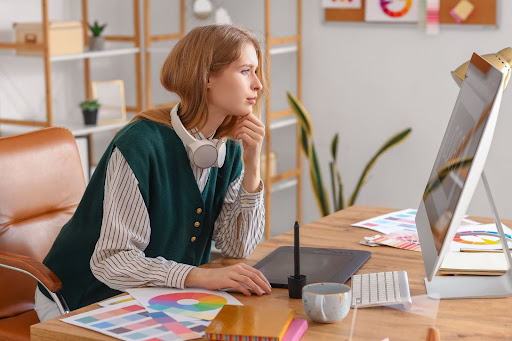In today’s saturated digital landscape, standing out with a business blog requires more than just quality content—it demands exceptional graphic design. The visual presentation of your blog plays a critical role in attracting and retaining readers, establishing brand identity, and enhancing the user experience. From consistent branding to interactive elements, employing smart design strategies can transform your blog into a powerful tool that drives engagement and sets you apart in a crowded market.
Brand Consistency
Brand consistency begins with a well-defined color palette that reflects your business’s identity and values. By using the same colors across your blog, social media platforms, and other branding materials, you create a cohesive look and feel that strengthens brand recognition. Every color choice should be intentional, ensuring that it aligns with the tone of your content and appeals to your target audience.
Typography also plays a crucial role in maintaining consistency. Select fonts that reflect your brand’s personality and are easy to read across various devices. Establish a hierarchy with consistent font sizes for headers, sub-headers, and body text to improve readability and create a professional appearance. Consistency in typography across all your blog posts helps create a unified visual language that readers can quickly recognize.
Utilizing a reliable CMS with customizable templates aids in maintaining brand consistency across your blog. Platforms like WordPress, Squarespace, or Joomla offer pre-built templates that can be tailored to reflect your brand’s color scheme, typography, and layout. A good CMS allows you to ensure that every blog post aligns with your established brand identity, even as your content grows.
High-Quality Imagery
Using original photography is a powerful way to make your blog unique and personal. High-quality, custom images can resonate more effectively with your audience than generic stock photos. If original photography isn’t an option, be selective with stock images, choosing only those that are high-quality and relevant to the specific content of your blog posts.
Additionally, custom graphics, such as illustrations, icons, and infographics, are key to enhancing your blog’s visual appeal. These elements not only break up long sections of text but also allow you to present information more engagingly. To keep your blog visually appealing and accessible, ensure that all images and graphics are properly optimized to maintain fast load times without compromising quality.
Consistent Layouts
Providing a consistent and clean layout to your blog is also essential for encouraging visitors to explore your website. Effective use of white space in your blog design can significantly enhance readability and draw attention to key elements. By giving your content room to breathe, you create a more pleasant reading experience for your audience. Properly managed white space prevents your blog from feeling cluttered and overwhelming, ensuring that important messages don’t get lost in a sea of text.
Additionally, grid systems help maintain a structured and organized layout, making it easier for readers to follow your content. A consistent layout also creates a sense of familiarity, so readers know what to expect when they visit your blog. Establish a balance between your content and design elements by using grids to align images, text, and other visual elements in a harmonious way.
Animations and Interactivity
Small, subtle animations, often called microinteractions, can greatly enhance the user experience on your blog. Hover effects, clickable buttons, and scroll-triggered animations add an extra layer of engagement, making your blog feel more dynamic without overwhelming the reader. These subtle touches can guide users through the content while keeping their attention.
Interactivity also goes beyond simple animations—consider incorporating elements like polls, quizzes, and clickable infographics to create a more engaging experience. Interactive content encourages readers to actively participate rather than passively consume, which can lead to higher engagement rates and a more memorable experience on your blog.
If your business blog requires formal agreements, contracts, or document signing (for instance, in the legal, real estate, or finance industries), integrating an electronic signature system can streamline these processes. Providing the ability to sign documents directly through your blog increases interactivity and simplifies the user experience, keeping everything within your platform without the need for external tools.
SEO-Optimized Graphics

SEO goes beyond just written content—images play an important role as well. Adding descriptive alt text to your images helps search engines understand the content, which can improve your blog’s visibility in search results. Alt text also enhances accessibility, allowing screen readers to describe images for visually impaired users, making your blog more inclusive.
Another good SEO habit is properly naming your image files. Use descriptive file names that incorporate relevant keywords to help search engines index your images correctly. This small detail can contribute to higher search rankings, driving more traffic to your blog over time.
Social Media Integration
Social media integration is another extremely important consideration. Creating graphics that are optimized for social sharing is essential for expanding your blog’s reach. Eye-catching, shareable visuals that include your logo or website URL can help spread your content across social platforms. These graphics should be tailored for specific platforms, considering dimensions and content styles to maximize their effectiveness.
To take it even further, you should create custom thumbnails for each blog post. This is a great way to attract attention on both your blog and social media. A well-designed thumbnail acts as a visual preview of the content and should align with your brand’s aesthetic. Consistent branding across thumbnails reinforces your identity and makes your posts more recognizable when shared across various platforms.
Cohesive Visual Identity
Establishing a consistent theme for your blog posts is essential for creating a cohesive visual identity. This can be achieved through recurring design elements such as banners, separators, or icons that tie your posts together visually. By maintaining a consistent look and feel across all your content, you help readers associate these visual cues with your brand, reinforcing brand recognition.
Visual hierarchy is a design principle that uses size, color, and placement to guide readers through your content. Proper use of visual hierarchy can make your blog posts easier to navigate, ensuring that readers focus on the most important information first. By organizing your content in a visually structured way, you can improve the flow of information and make it more accessible to your audience.
Becoming the top business blog
Incorporating thoughtful graphic design into your business blog is essential for making a lasting impression in an increasingly competitive online environment. By focusing on brand consistency, engaging visuals, responsive layouts, and seamless integrations like electronic signatures, you can create a blog that not only captures attention but also strengthens your brand’s authority and fosters deeper connections with your audience. With these design essentials, your blog can stand out and become a dynamic extension of your business.






